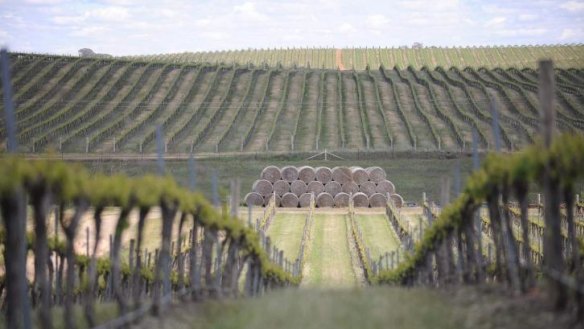NSW's Orange wine-making region is on the rise

In Orange, "altitude is the difference", according to the NSW wine region's current promotional slogan. Orange trades on its altitude because high equals cool, and cool is, well, cool. The Orange wine region is officially defined as beginning at 600 metres above sea level.
So strict is the boundary line that there are several vineyards in the area which straddle the 600-metre contour. Angullong and Cumulus are two. Grapes from the portion of their vineyards on the right side of the contour line are entitled to the Orange regional appellation. Those on the wrong side are permitted to use the zonal name: Central Ranges.
It's a critical point, because altitude is everything in Orange. There are two ways to achieve a cool viticultural climate in Australia: altitude and latitude. Being located on a similar latitude to Sydney, Orange would be too warm for finer winegrowing if it weren't situated on a high plateau. That plateau surrounds an ancient volcano just outside the city of Orange: the 1396-metre Mount Canobolas. Orange region vineyards are at altitudes from 600 metres all the way up to more than 1000 metres on the upper slopes of Mount Canobolas.
Charlie and Loretta Svenson of De Salis Wines at Nashdale grow their vines at 1050 metres, with a stunning view and a plumb north-facing slope. "We get cooling breezes here, so the temperature is two to three degrees cooler than in the valleys," says Charlie Svenson. Not content with that, the Svensons recently purchased the Crawford family's vineyard Forest Edge, which is just 1.5km away at a similar altitude but with different soil.
The cool sites suit the wines they make: sauvignon blanc, chardonnay, pinot noir and sparkling wines. They are gearing up to increase their bubbly output, having invested in their own bottling and disgorging equipment, and pride themselves on being the region's only sparkling producers who grow, make, bottle and disgorge it themselves. The De Salis style is complex and big flavoured, with barrel fermentation, long ageing on lees and a dry finish, thanks to low liqueur levels.
Doing more with sauvignon blanc
De Salis's Lofty Fume Blanc is also a complex style: it does more with the sauvignon blanc grape than most, and the Lofty pinot noirs (both white and blue labels) are arguably the most impressive pinots yet from Orange.
Svenson's mentor was Murray Smith at Canobolas-Smith, who is one of Orange's earliest vignerons and makes the region's most complex and profound chardonnays. His 2012 Shine Chardonnay is one of his best, and won a gold medal at the 2015 Orange Wine Show. The protege also shone, winning a gold medal for the 2013 De Salis Wild Chardonnay in the same class.
In a region of colourful people who are all individuals, with their own ways of doing things, their own style and expression, Gerald Naef is also a chardonnay specialist. His Patina vineyard is at Lucknow on the Sydney side of Orange, and cellar door visitors are welcomed into the family home, no less. This is set in a stunning and expansive garden which Gerald's wife Angela established.
Gerald Naef started his winemaking self-taught, and picked up a degree in wine science along the way, but he is still very much an individualist whose wines are full of flavour and character, and are anything but the refined, pure-fruit style favoured in some quarters. Angela is also an artist. But why Patina? "Aged lustre – the signature of time and environment" is Gerald's definition of patina, and the resonance between art and wine is obvious. Patina's 2013 Reserve Chardonnay won the top gold medal in its class at the Orange show, and carried off the trophy for best older vintage chardonnay.
Three trophies – for best chardonnay of show, best white wine and best wine of show – were scooped by Carillion The Crystals Chardonnay 2014, which is part of the Hunter Valley-based Davis group and was made in the Hunter.
A less-expensive and more fruit-driven style of chardonnay is made by some wineries such as Cumulus and Angullong. Indeed, Angullong's Fossil Hill range, which encompasses barbera, sangiovese, tempranillo and shiraz viognier, is arguably the best value for money label in the region. Angullong's wines were made at First Creek in the Hunter but since 2015 are being made locally at Printhie.
Shiraz is the workhorse
Despite the excitement over white wines, Orange's most-planted grape is the industry workhorse, shiraz. Best grown in warmer, lower-altitude sites, it can be rich and spicy – often peppery – elegant and finely textured. Montoro is an example: this two-hectare vineyard beside the Cargo Road at Nashdale sits at 900 metres and is entirely planted to shiraz. From this, contract winemaker Will Rikard-Bell fashions a rose, a full-bodied red and a vintage port-style fortified. The 2014 rose, named End Of The Day Rose, is a winner. Beautifully textured, savoury and appetisingly dry, it's barrel fermented and slurpable: a wine I could stick with for several glasses.
Other good shirazes are coming from Philip Shaw, Cooks Lot, Printhie (especially the Super Duper), and Ross Hill Pinnacle. Indeed, the 2015 Pinnacle – still in the barrels – is the best red wine the makers Phil and Rochelle Kerney reckon they've made yet. I agree: it's a stunning wine, one to make a note to buy in two years' time. Like a lot of Orange wineries, progress is being steadily made and one senses that the best is yet to come.
